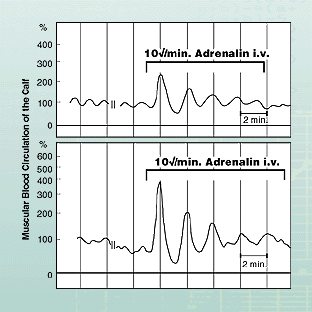| DEUTSCHE JUGEND UNIVERSITÄT |
| DEUTSCHE JUGEND UNIVERSITÄT |
| SCIENTIFICALLY INTRODUCING UNIVERSALITY TO THE UNIVERSITY |
| . |
. | .Deutsche Übersetzung in Arbeit |
Prof. Dr. med. Gunther Hildebrandt • Chronobiological Aspects of Music Physiology
As an example for a short wave reactive periodic illustration 23 shows the plot of the blood circulation in calf muscle of two subjects whose metabolic balance in the musculature was disturbed by infusion of a vascular active hormone (adrenalin). While in a condition of rest the muscular blood circulation varies spontaneously in a 1-min.-rhythm, a 2-minute reactive periodic is triggered by the disturbance whose swings are initially much greater, but then decrease with continuing compensation, falling back again into the spontaneous 1-min.-rhythm.

Illustration 23
Two examples of the reactive-periodic process of the muscular blood circulation in humans during an intravenous infusion of adrenalin. In the left part of the picture, spontaneous variations of muscular blood circulation in a 1-min-rhythm from the same investigations are shown.
(According to GOLENHOFEN 1962, amended)